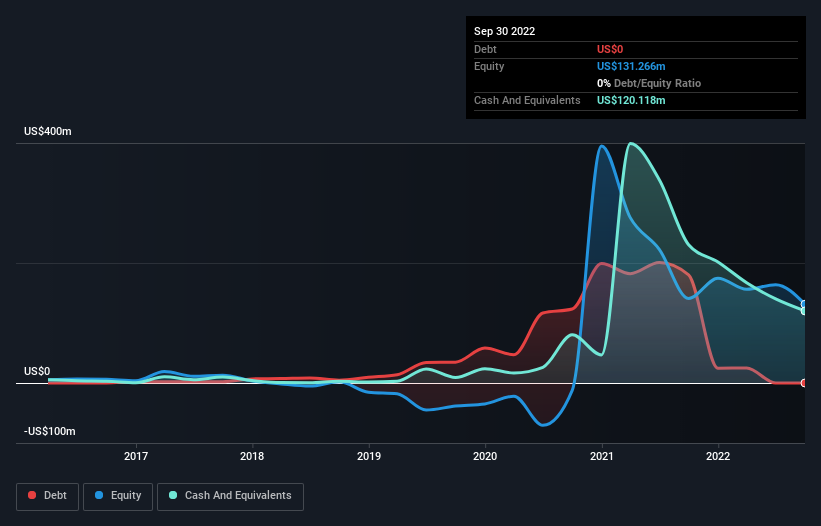Even when a business is losing money, it’s possible for shareholders to make money if they buy a good business at the right price. For example, although software-as-a-service business Salesforce.com lost money for years while it grew recurring revenue, if you held shares since 2005, you’d have done very well indeed. Nonetheless, only a fool would ignore the risk that a loss making company burns through its cash too quickly.
Given this risk, we thought we’d take a look at whether Workhorse Group (NASDAQ:WKHS) shareholders should be worried about its cash burn. In this article, we define cash burn as its annual (negative) free cash flow, which is the amount of money a company spends each year to fund its growth. We’ll start by comparing its cash burn with its cash reserves in order to calculate its cash runway.
Check out our latest analysis for Workhorse Group
When Might Workhorse Group Run Out Of Money?
A cash runway is defined as the length of time it would take a company to run out of money if it kept spending at its current rate of cash burn. As at September 2022, Workhorse Group had cash of US$120m and no debt. Looking at the last year, the company burnt through US$100m. That means it had a cash runway of around 14 months as of September 2022. That’s not too bad, but it’s fair to say the end of the cash runway is in sight, unless cash burn reduces drastically. You can see how its cash balance has changed over time in the image below.
How Is Workhorse Group’s Cash Burn Changing Over Time?
Because Workhorse Group isn’t currently generating revenue, we consider it an early-stage business. Nonetheless, we can still examine its cash burn trajectory as part of our assessment of its cash burn situation. Even though it doesn’t get us excited, the 34% reduction in cash burn year on year does suggest the company can continue operating for quite some time. While the past is always worth studying, it is the future that matters most of all. So you might want to take a peek at how much the company is expected to grow in the next few years.
How Easily Can Workhorse Group Raise Cash?
Even though it has reduced its cash burn recently, shareholders should still consider how easy it would be for Workhorse Group to raise more cash in the future. Issuing new shares, or taking on debt, are the most common ways for a listed company to raise more money for its business. Many companies end up issuing new shares to fund future growth. By comparing a company’s annual cash burn to its total market capitalisation, we can estimate roughly how many shares it would have to issue in order to run the company for another year (at the same burn rate).
Workhorse Group has a market capitalisation of US$354m and burnt through US$100m last year, which is 28% of the company’s market value. That’s not insignificant, and if the company had to sell enough shares to fund another year’s growth at the current share price, you’d likely witness fairly costly dilution.
How Risky Is Workhorse Group’s Cash Burn Situation?
Even though its cash burn relative to its market cap makes us a little nervous, we are compelled to mention that we thought Workhorse Group’s cash burn reduction was relatively promising. Even though we don’t think it has a problem with its cash burn, the analysis we’ve done in this article does suggest that shareholders should give some careful thought to the potential cost of raising more money in the future. Taking a deeper dive, we’ve spotted 4 warning signs for Workhorse Group you should be aware of, and 1 of them shouldn’t be ignored.
Of course Workhorse Group may not be the best stock to buy. So you may wish to see this free collection of companies boasting high return on equity, or this list of stocks that insiders are buying.
Have feedback on this article? Concerned about the content? Get in touch with us directly. Alternatively, email editorial-team (at) simplywallst.com.
This article by Simply Wall St is general in nature. We provide commentary based on historical data and analyst forecasts only using an unbiased methodology and our articles are not intended to be financial advice. It does not constitute a recommendation to buy or sell any stock, and does not take account of your objectives, or your financial situation. We aim to bring you long-term focused analysis driven by fundamental data. Note that our analysis may not factor in the latest price-sensitive company announcements or qualitative material. Simply Wall St has no position in any stocks mentioned.
Join A Paid User Research Session
You’ll receive a US$30 Amazon Gift card for 1 hour of your time while helping us build better investing tools for the individual investors like yourself. Sign up here
